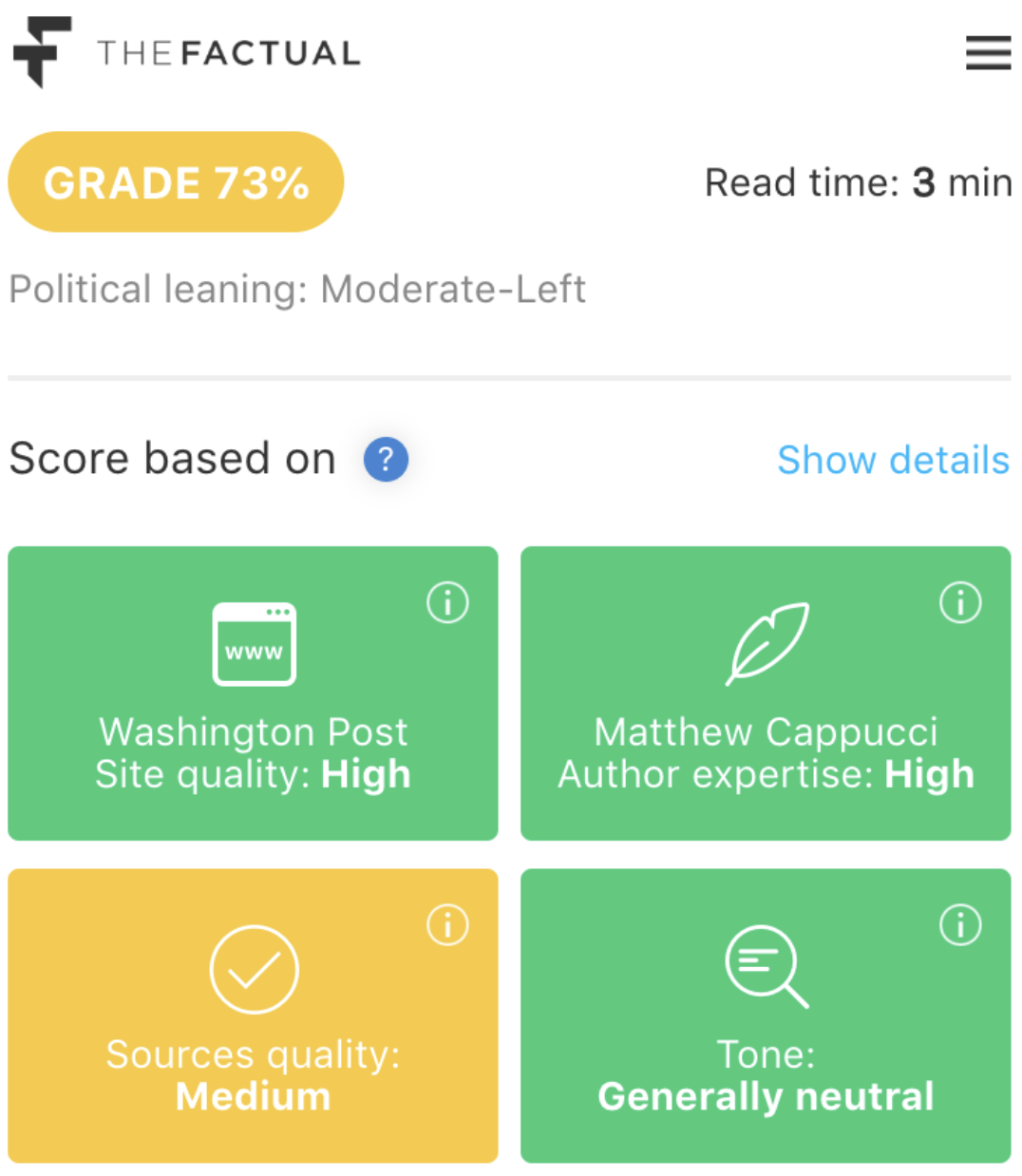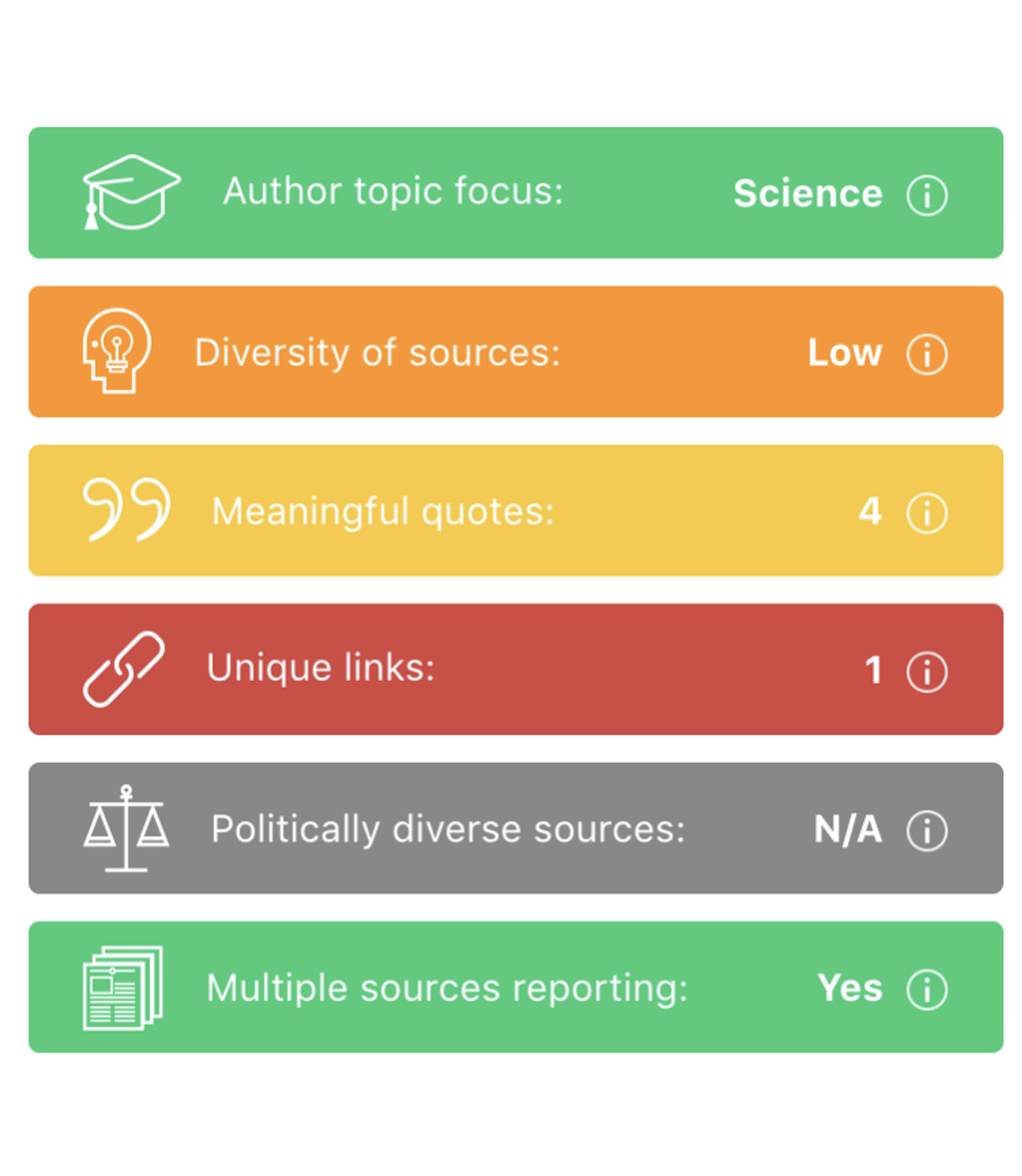How It Works
What is The Factual?
The Factual is an algorithm that rates 10,000+ news articles daily for how informative they are. You can see these ratings on our website showing live trending topics with thousands of related articles grouped together and allowing you to filter by political leaning, grade and more.
How does The Factual Grade measure how informative an article is?
Each article receives a grade between 1-100% based on four metrics: the site quality, the author’s expertise, the quality and diversity of sources, and the tone of the writing. Each of these metrics answers key questions about the information value of the article.
Site quality: Does this site have a history of producing well-sourced, highly-informative articles?
Author’s expertise: Does the author have a track record of writing well-researched, informative articles on the topic? Does the author focus on the topic and hence may have some expertise?
Quality and diversity of sources: How many unique sources and direct quotes were used in the article? What is the site rating of those sources?
Article’s tone: Was the article written in a neutral, non-opinionated tone or was it opinionated with emotional language?
These four metrics combine to give a single percentage grade, which we interpret as the probability of the article being informative. Grades above 75% are regarded as highly likely to be informative while grades below 50% are less likely to be informative.
The Factual has graded 10 million articles over the last three years, which produces a frame of reference for the grades it assigns to articles. Because the algorithm functions without human input, The Factual can offer a consistent assessment of news articles in just seconds and help counter our own biases.
How does The Factual's algorithm minimize bias?
What does The Factual Grade look like?
Let’s analyze this article from the Washington Post, for example. Clicking on The Factual’s Chrome extension shows the overall grade for the article, the political leaning of the outlet, the estimated read time, and an explanation for the score the article received.

Grade: Articles that score 75% or higher will appear in green, those between 50% and 75% will appear in yellow, and articles below 50% will appear in orange color. At 73%, this article is moderately informative.
Political leaning: The Washington Post is considered Moderate-Left based on data from AllSides and Media Bias Fact Check — the two non-partisan websites that we use to assess the political orientation of news outlets. Note that bias ratings don't factor into The Factual Grade and are provided merely as context for how a story may be framed.
Site quality: Sites that have a history of producing high-scoring articles will have a higher site quality rating, as is the case here with Washington Post.
Author expertise: Author expertise looks at the author’s history of articles, looking to see if they are highly informative, as well as how much they have written about the topic in the past. Here, Matthew Cappucci has written extensively on meteorology before, so he has a High expertise rating on this science topic.
Sources quality: This is a measure of the quality and diversity of sources within the article. This looks to measure how many unique sources were cited in the article, as well as how many direct quotes (of at least 5 words) were used. In this case, there is just 1 link and only 4 quotes which result in a Medium source quality rating.
Want to drill down even further?
Clicking on the "Show Details" button on the Chrome extension gives you a more in-depth explanation of the score, complete with explanations for how each metric works.

Known Issues
Keep in mind that The Factual cannot always obtain scores or may return imperfect scores for articles for a number of reasons:
- Sites that have paywalls or exceptional formatting (often seen in longform articles) cannot always be assessed.
- Articles shorter than 250 words are not assessed.
- Multimedia links within articles, such as tweets, videos, and photos, are not always accounted for by the algorithm.
- The same author writing for two different sites will be treated as two different authors by the scoring algorithm. This means the same author could be rated highly on an outlet that they write for frequently, but have no rating on an outlet they haven’t previously written for.
- Some sites don’t have authors at all (e.g., Reuters or the Economist) or the algorithm is unable to pull that information due to the formatting (e.g., South China Morning Post). The articles still may be informative but because The Factual could not validate some elements the articles with rate lower.
- Some sites choose not to link to external sources as a stylistic choice. The Factual will rate these articles lower since it's harder for a reader to verify evidence presented.
- Non-English sites are not yet rated by The Factual.
- Left-leaning sites are featured more often than right-leaning sites. This is not indicative of a left-bias in the algorithm.